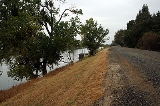
Levee
Overview
A levee, levée, dike embankment, floodbank or stopbank is an elongated naturally occurring ridge or artificially constructed fill
or wall, which regulates water levels. It is usually earthen
and often parallel
to the course of a river
in its floodplain
or along low-lying coastlines.
The word levee, from the French word levée (from the feminine past participle of the French verb lever, "to raise"), is used in American English
(notably in the Midwest and Deep South
).
Fill dirt
Fill dirt is earthy material which is used to fill in a depression or hole in the ground or create mounds or otherwise artificially change the grade or elevation of real property....
or wall, which regulates water levels. It is usually earthen
Soil
Soil is a natural body consisting of layers of mineral constituents of variable thicknesses, which differ from the parent materials in their morphological, physical, chemical, and mineralogical characteristics...
and often parallel
Parallel (geometry)
Parallelism is a term in geometry and in everyday life that refers to a property in Euclidean space of two or more lines or planes, or a combination of these. The assumed existence and properties of parallel lines are the basis of Euclid's parallel postulate. Two lines in a plane that do not...
to the course of a river
River
A river is a natural watercourse, usually freshwater, flowing towards an ocean, a lake, a sea, or another river. In a few cases, a river simply flows into the ground or dries up completely before reaching another body of water. Small rivers may also be called by several other names, including...
in its floodplain
Floodplain
A floodplain, or flood plain, is a flat or nearly flat land adjacent a stream or river that stretches from the banks of its channel to the base of the enclosing valley walls and experiences flooding during periods of high discharge...
or along low-lying coastlines.
The word levee, from the French word levée (from the feminine past participle of the French verb lever, "to raise"), is used in American English
American English
American English is a set of dialects of the English language used mostly in the United States. Approximately two-thirds of the world's native speakers of English live in the United States....
(notably in the Midwest and Deep South
Deep South
The Deep South is a descriptive category of the cultural and geographic subregions in the American South. Historically, it is differentiated from the "Upper South" as being the states which were most dependent on plantation type agriculture during the pre-Civil War period...
).
Unanswered Questions

